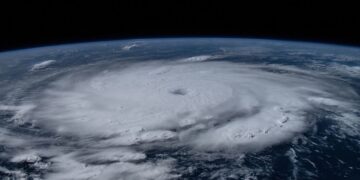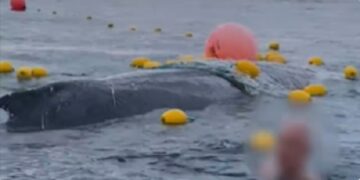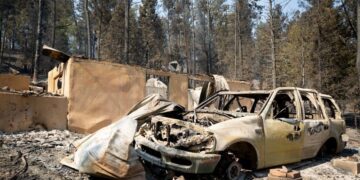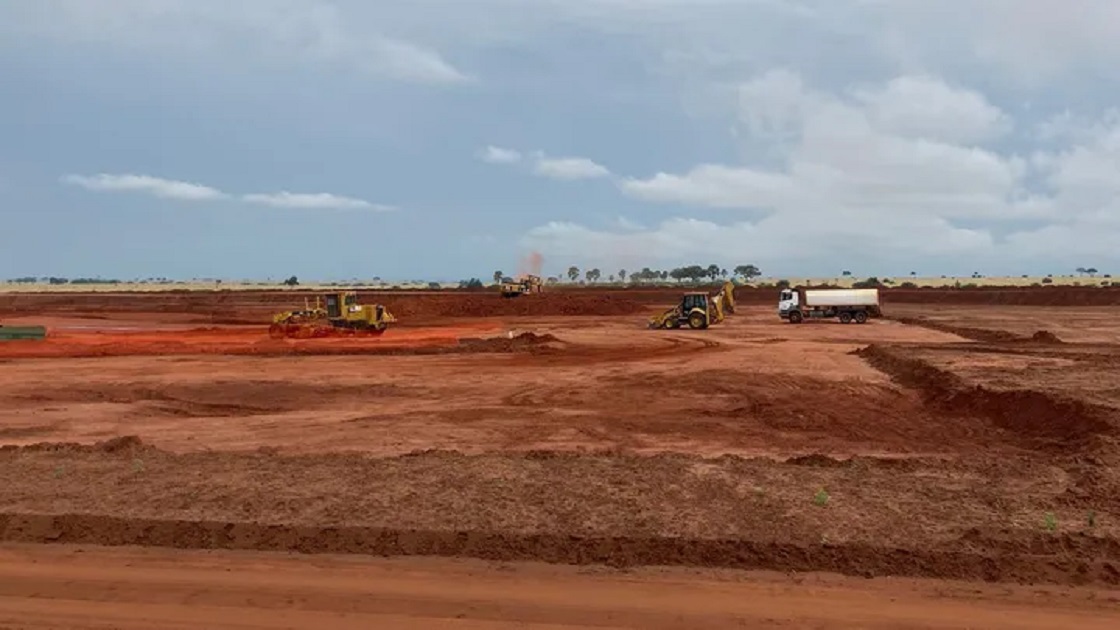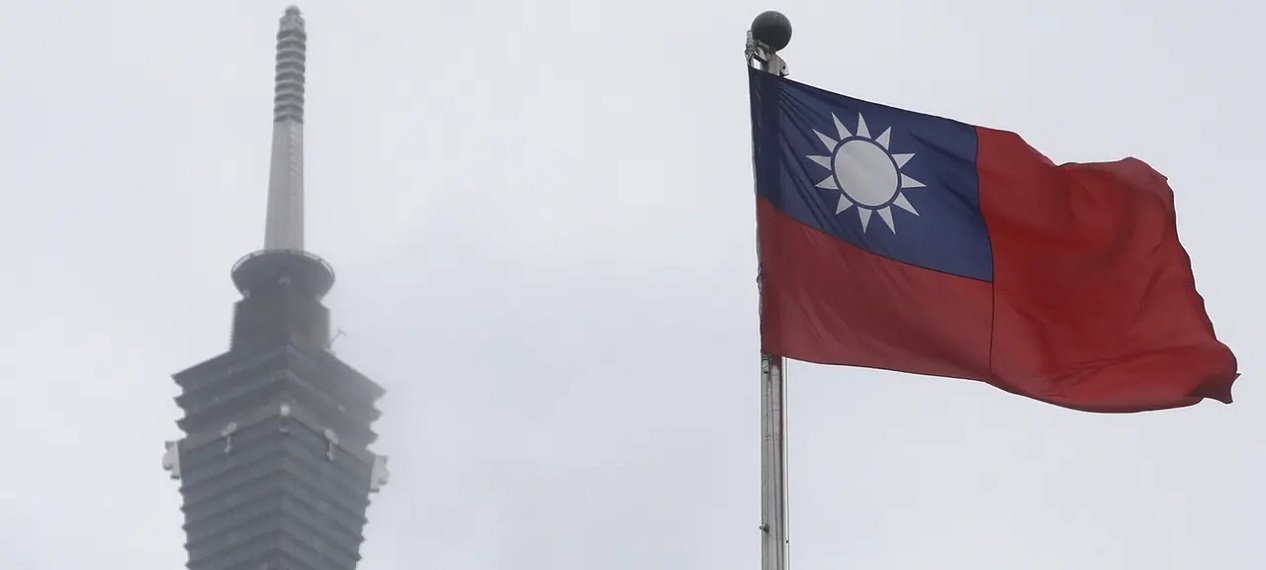While justice will soon render its judgment in the case between six NGOs and Total, the Cellule investigation and the International editorial staff of Radio France investigated with the editorial staff of RFI the consequences of its oil project in Uganda and Tanzania.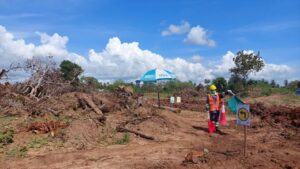 Mathieu Faget, the manager of the future oil storage site on the Tanzanian coast. (AFP)
Mathieu Faget, the manager of the future oil storage site on the Tanzanian coast. (AFP)
The majestic Nile undulates in the heart of a verdant forest… It is here, in the Lake Albert region, in northwestern Uganda, that Total Energies will extract the precious black gold. Work has started. Backhoe loaders return the savannah. At the top of the embankments of red earth intended to attenuate the noise of the machines, curious antelopes come to observe the construction sites.
In Uganda, oil reserves are estimated at 6.5 billion barrels, of which 1.4 billion would be exploitable. When production reaches cruising speed, nearly 200,000 barrels of oil per day should be exported. To achieve this objective, the project, in which Total is the majority shareholder, is divided into two parts. The first, Tilenga, involves pumping and processing oil. 31 extraction zones are planned, for a total of 426 wells, as well as a processing plant. The second component, the East African Crude Oil Pipeline (EACOP), will result in the construction of a buried pipeline over more than 1,440 kilometers. The longest heated oil pipeline in the world.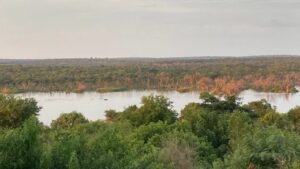 A branch of the Nile crosses Murchison Falls Park, Uganda, July 16, 2022.
A branch of the Nile crosses Murchison Falls Park, Uganda, July 16, 2022.
A sensitive natural area under threat
Problem: the oil extraction will take place partly in the Murchison Falls Park, a classified site of the International Union for the Conservation of Nature. Composed of a very rich fauna and flora, there are lions, elephants, giraffes, buffaloes, antelopes… 144 species of mammals, more than 500 species of birds, reptiles and amphibians are listed there. In Uganda, it is the most visited park. However, the company was awarded 10% of the 3,840 km² that make it up.
Developing an oil activity in such a sensitive area therefore worries NGOs and part of civil society. “This park is closely intertwined with our largest forest reserve, explains Dickens Kamugisha, the manager of Afiego, one of the organizations suing Total in France. One of the longest rivers in Africa, the Nile, crosses the Murchison Falls. We must protect it as an essential biodiversity resource for our country.”
To this, Total Energies responds that it will use less than 1% of the area allocated to it. He assures that he will deploy an arsenal of specific measures to limit the consequences of his presence. It even undertakes, we are assured, to “produce a net positive impact on biodiversity”, for example by contributing to the increase in chimpanzee populations or by reintroducing black rhinos.
Horizontal drilling
Another argument advanced: inside the park, the drilling zones will be limited to 10, for approximately 130 wells, thanks to a technique consisting in digging horizontally. The platform will be like a trunk whose roots would circulate in the basement, invisibly. “It would have been easy to drill vertically, assures Pauline Mac Ronald, Environment & Biodiversity Manager for Total Energies in Uganda, and therefore to multiply the drilling. But as we are in the park, we have selected a few locations where we can extract the oil with minimal impact.”
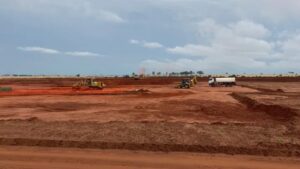 Vehicles prepare one of the future oil extraction sites in Murchison Falls Park in Uganda, July 18, 2022.
Vehicles prepare one of the future oil extraction sites in Murchison Falls Park in Uganda, July 18, 2022.
The specialized American organization E-tech, which provides technical support to communities affected by major development projects, however considers that 10 platforms is still too many. “In the park, we should reduce the number of platforms to one, and drill from outside the park,” says Bill Powers, the chief engineer of E-tech. A recommendation that Total Energies claims is technically untenable. The group specifies that “locations have been designed to minimize the visual impact of the platforms”. And specific facilities (traffic corridors) have been planned to facilitate the passage of animals.
Other concerns relate to the possible effects induced by the project. A large paved road already crosses the park. A contributor to WWF’s 2017 report believes the pipeline could be “a gateway for oil sector expansion” in the region. Once built, other companies could be tempted to invest and carry out exploration activities, thus multiplying the risks for the environment. And in fact, among the projects already planned in the region, there is the creation of an airport and a refinery for local use of oil.
A pipeline bordering a national park
Once extracted, the crude oil will be processed in Uganda and then transported in what will be the longest heated pipeline in the world. Viscous oil must be held at a certain temperature in order to circulate. It will thus cross Uganda from north-west to south-east, and follow for nearly 400 kilometers the largest lake in Africa, Lake Victoria, whose ecosystems, again, are important and fragile. According to the World Bank, 40 million people live on these outskirts. And here again, the NGOs warn: any incident could have a serious impact for the entire region.
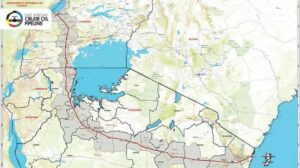 Map showing the route of the future Total Energies pipeline crossing Uganda and Tanzania. (eacop.com)
Map showing the route of the future Total Energies pipeline crossing Uganda and Tanzania. (eacop.com)
The pipeline will then cross Tanzania for more than 1,000 kilometers to reach the Indian Ocean. Something to worry about, again, since this country is also famous for the richness of its landscapes and its wildlife: elephants, giraffes and other lions. “There is absolutely no centimeter of pipeline, in the Tanzanian part, which passes through a national park or through an environmental protected area, storms however January Makamba, the Tanzanian Minister of Energy, adding that this idea that we are irresponsible to our people and our future generations is condescending and unacceptable.”
Total, however, recognizes that the oil will pass through certain reserves, including a national park in the Burigi-Biharamulo region, in northwestern Tanzania. There “live chimpanzees and elephants, worries environmental activist Richard Senkondo. The construction of the pipeline will increase the pressure on these endangered species.” But Total once again justifies its route. Certainly, “the pipeline will pass through an area bordering the national park which is already highly degraded”, insists Jennifer Nyanda, ex-member of the WWF, now diversity coordinator on the EACOP project. But according to her, “all sensitive areas will be avoided.” To demonstrate this, it takes us further east, to the edge of the Swaga Swaga reserve, which the pipeline will also cross. The area is already deprived of its trees. The acacias have been replaced by corn and sunflower crops. “There is no longer any trace of wildlife, notes Jennifer Nyanda. A few years ago, there were a lot of lions, but because of human activities, they have all gone.”
Already massive deforestation
To install the pipeline, construction machinery will clear a 30-meter-wide corridor, the equivalent of a large highway, across the country. The pipe, currently cut into sections, will be buried, and vegetation will then be able to grow over it, with the exception of trees whose root system could damage the pipe. This project will add to an already massive deforestation in Tanzania. “400,000 hectares of forest disappear every year and that has nothing to do with Total’s activities”, relativizes Jennifer Nyanda, however. The problem in the country is major recognize the authorities. The poorest populations often collect the wood to transform it into charcoal, sell it or use it for their daily cooking.
A ballet of tankers
At the end of the route, there is the Indian Ocean. There, the oil will be stored in the Tanga region, by the sea, near the Kenyan border. Work has already started. Construction machinery removes vegetation. All that remains is ocher soil and, here and there, a few baobabs. On this 72-hectare site, four reservoirs, 20 meters high and 80 meters in diameter, will be installed. “The pipeline will have continuous production, explains the manager of the future terminal, Mathieu Faget. The oil will be poured into these tanks while the tankers moor and take it away.” And to prevent these tankers over 300 meters long from getting too close to the coast, a two-kilometre jetty will be built near the Coelacanth Marine Park, a protected marine area.
 The construction site of the future oil storage site, in the Tanga region.
The construction site of the future oil storage site, in the Tanga region.
In this region dotted with mangroves, concerns are high. According to environmental activist Richard Senkondo, possible “leaks would affect the whole local ecosystem, the life of fish, microorganisms. The construction of the pier will also damage the coral reefs which are very sensitive”. Total ensures that all precautions have been taken, from the thickness of the pipeline to vigilance against earthquakes, in an otherwise seismic zone. But “any pipeline under construction is going to have leaks at some point,” retorts Bill Powers, the chief engineer of E-tech, who has worked for nearly 30 years in the oil industry. “That doesn’t mean it’s going to leak massively. But the idea that it’s impossible for oil to leak is wrong.”
Rashidi Machuanafega, a fisherman whose boat is on a sandy beach, very close to the future pier, is also worried: “If a leak occurs, the fish will drink water with oil.” But his main concern is the construction of the pier. “That’s where we fish the most. As soon as they start building the bridge, we local fishermen won’t be allowed to go through that anymore.” And fishing elsewhere is impossible, he explains. “With my traditional boat, I can’t face the wind. That’s why I always go there.” He therefore hopes to obtain authorization to fish between the “pylons” of the pier… Or else, to receive compensation.
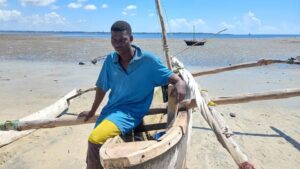 Rashidi, a fisherman from Poutini, recounts his concern about the consequences of the Total project on his work.
Rashidi, a fisherman from Poutini, recounts his concern about the consequences of the Total project on his work.
Displaced families
To carry out its project, Total Energies must use land on which people live and cultivate. In all, more than 100,000 people are affected by the project according to the NGOs, some because they lose a simple piece of land, but others because they have to be rehoused. Total Energies often prefers to speak of 19,000 households, although each of them includes several people. As for the CEO of Total Energies, Patrick Pouyanne, he mentioned on November 9 last before the Foreign Affairs Committee of the National Assembly, the number of 769 displaced households.
Total Energies provides for the rehousing of certain families in permanent houses in the event of the destruction of the main dwelling, or financial compensation. A situation sometimes experienced painfully. Thus, Jealousy Mugisha, a 50-year-old Ugandan farmer, father of seven children, saw his hut classified as a place of secondary habitat. For its destruction, he was therefore only entitled to financial compensation. “Our land has been seized and fenced off,” he says. According to him, “the process is not fair, it has only been intimidation and harassment”. But he is one of the few to have challenged this decision, because the procedures are long, complicated and expensive for the inhabitants of these rural communities, poorly educated and often relatively poor. To which Total Energies spokesperson for Tilenga / EACOP, Cheick-Omar Diallo, assures that the company takes “firmly into account the question of human rights” and ensures “that they are applied”.
“Life has become more difficult”
The majority of Ugandans ended up accepting the transfer of their lands, while formulating numerous criticisms of the way in which the procedures were carried out. Land confiscation sometimes happens too soon, some say. There would have been delays in the payment of compensation. And compensation often considered too low, especially given the soaring land prices in the region since the announcement of the project. To this, Total Energies replies that it complies with transparent scales. According to Jeremy Roeygens, head of land issues for Total in Uganda, “the value of the land is documented by the districts. A small, medium or large banana tree has a very clear value, officially identified.” As for issues regarding late payments and land use restrictions, the company claims to have made mark-ups and compensations.
But a certain bitterness remains palpable. For Maxwell Atuhura, an activist from the oil zone: “There is nothing that Total can compensate for that is equivalent to what people lose. They compensate me for my land, but not for the loss of my means of subsistence.” And this feeling can also be seen in Tanzania. In the village of Poutini, near the future oil storage site, Fatou Mabdala agreed to sell the land on which mango and cashew trees grew. “We were getting income from this land. Now we have to buy our food. We received two million Tanzanian shillings when we should have received 6 million. But we couldn’t negotiate. The owner is the government.” [One million Tanzanian shillings is worth around 400 euros, Ed.]
In this country, land belongs to the state. This peculiarity partly explains why the EACOP project chose to route its giant pipeline through Tanzania rather than Kenya. A route that would have been more direct. “In Kenya, land is private property. It is very expensive to acquire, explains Hilary Ballonzi, a lawyer and activist based in Dar-Es-Salaam. But in Tanzania, the government controls things. influence and having it on your side makes it easy to acquire land.” This does not prevent the inhabitants from being compensated. “But we have two types of evaluators in Tanzania, specifies the lawyer: those of the government and the private ones. However, people who live in poverty do not have the means to hire a private evaluator.”
Total’s communication operation
Much criticized for the lack of information given to local populations when the project was launched, Total Energies is now seeking to rectify the situation. In the city of Arusha, in northern Tanzania, it regularly brings together representatives of so-called vulnerable ethnic groups: Barabaigs and Maasai in particular. In December 2022, a final meeting took place in the conference room of a large hotel. On one side, the leaders of the tribes, often dressed in colorful traditional clothes and leather sandals, who traveled hundreds of kilometers by bus to attend the exchanges. On the other, an extremely luxurious setting, where the water basins dotted with water lilies contrast with the drought that affects part of the country.
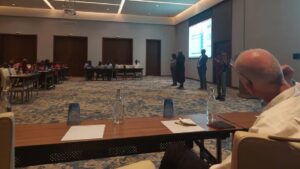 Information meeting on the EACOP project in a large hotel in Arusha, Tanzania.
Information meeting on the EACOP project in a large hotel in Arusha, Tanzania.
In the room, translators are responsible for facilitating exchanges. And the public does not seem refractory to the project. “The rains are decreasing, we lack water for our animals,” laments Maasai leader Rafaele Mangole. But if he suffers from the effects of climate change, he does not link them to the impact of oil activities. “It’s a natural evolution, he explains. We experienced these changes before the arrival of the EACOP project. We will just have the raw material, the oil, which will pass through here. It will not affect us. .”
Total maintains that its project will emit little CO2. 13.5 million tonnes over 20 years. “Emissions significantly lower than the African average, says Cheick-Omar Diallo, spokesperson for TotalEnergies for Tilenga / EACOP. Less than 13 kg of CO2 per barrel, when the African average is 33 kg.” These assessments, however, are nuanced by the Climate Accountability Institute. The director of this institute, Richard Heede, who carried out his own study on the EACOP project at the request of the New York University Law School, considers that the ancillary emissions generated by the project. “The EACOP environmental and social impact studies only concern the construction phase and the emissions produced during construction operations, he points out. But they hide the much larger emissions that are attributable to maritime transport. , crude oil refining and end-user emissions.” According to him, Total would only take into account 1.8% of the total greenhouse gas emissions linked to the project. TotalEnergies responds that the consumption of oil by end users does not have to be included in the calculations for a specific project like this.
People’s hope
Despite all these findings, the project raises hopes in the population. In Uganda, the money generated by the project should be allocated to a special fund to finance public infrastructure. According to Fred Kabagambe Kaliisa, the Ugandan president’s special adviser on oil issues, it should be used “for the development of roads, electricity infrastructure, for public services and education.” In Tanzania, too, some residents dream of getting a job. In the village of Poutini, near the future jetty, a group of people sit patiently, in the heat, in the shade of a large tree, watching the white 4x4s of the EACOP project come and go. “We heard that they paid good salaries, explains Amina. So we wait. There are people here who have been doing it for two years. This project is good for us, but the challenge is to to be a part of.”
 In the village of Poutini, the inhabitants live above all from fishing. Total’s project will directly impact their environment.
In the village of Poutini, the inhabitants live above all from fishing. Total’s project will directly impact their environment.
Result: the NGOs that fight the project are often perceived as “enrichment impediments”. But this vision of things, the activist Baracka Lenga regrets it. “We cannot be happy to make money off the back of the planet. We already have a problem with the rains. The level of the rivers has gone down because of climate change. This project will aggravate this crisis. However, in the rural areas, 99% of the people depend on the rain to cultivate. We will destroy their livelihood. How will they survive?”


